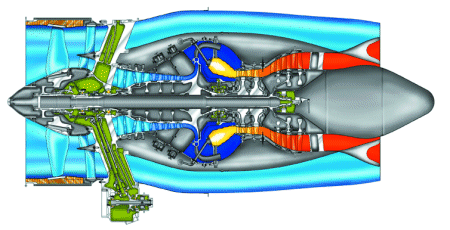Fairchild is moving on to developing a stretched 328JET
Paul Lewis/OBERPFAFFENHOFEN
Having completed certification of the turbofan-powered 328JET, Fairchild has turned its attention to the more challenging development of the larger 42/44-seat version. The 428JET, from an engineering standpoint, extends well beyond a straightforward fuselage stretch, encompassing a redesigned wing and a new powerplant.
"Our overall strategy for the 428JET is to add a member to the 328JET family, offering 44 seats spaced off 32 seats and giving us enough differential between the aircraft," says Stanley Deal, Fairchild vice-president for the 228/328/ 428 series. Atlantic Coast Airlines' launch order for 30 428JETs plus 25 328JETs provided "a good endorsement," he adds.
The most obvious external change to the 328JET will be a 4.3m (14ft) longer fuselage. The 428JET will incorporate a new 9.5m centre fuselage section extended forward and aft of the wing. To accommodate the additional 10-12 passengers, a second type 1 door will be added aft, the type 3 emergency exit repositioned and rear baggage hold enlarged to 9.51m³ (336ft³).
A good proportion of Fairchild's $150 million investment in the 428JET has been spent on a new wing. After several design iterations, it has settled on a 47.8m² (514.5ft²) wing, nearly 8m² larger than that of the 328. The chord has been widened by .53m (1.7ft) from the aft spar forward and the span increased by 800mm. It features an increased aspect ratio and rounded wing tips. "We've a concept now with the repositioning of the wing that gives us the right controllability. We plan to retain vertical and horizontal stabiliser commonality with the 328. The only further consideration being evaluated is a potential tab size change to give more controllability on the elevators," explains Deal.
About 310mm of the extended span is accounted for by enlarged inboard wing sections needed to create more access room for the 428JET's wider-diameter turbofan engines. With the kinked wing section moved outboard, designers have deleted rib 10 and added new two ribs. This in turn has facilitated an improvement on the 328JET's engine bridge mounting.
"When we converted the 328 turboprop to the JET, the bridge was the only option that maintained the same wing design and so saved time. In going to the 428, we're doing it properly and putting a conventional installation on it and that's saving us 40kg [88lb],"says J C Audit, Fairchild chief engineer, high-wing aircraft programmes.
The selected Pratt & Whitney Canada PW308B engine is an underwing-mounted adaptation of the PW308A, selected to power the Hawker Horizon business jet. The 7,400lb-thrust (33kN) engine (maximum rated at 8,000lb) is a scaled-up development of the 328JET's PW306B, conforming to the same basic two-shaft layout, but it has few actual parts in common, aside from the dual channel full-authority digital electronic control (Flight International, 18-24 August).

It has a wider 33.2in (843mm) diameter fan and, unlike the 306B, the Nordam-supplied nacelle will incorporate a thrust reverser as a baseline feature. High-wing aircraft such as the 328JET have not been fitted with thrust reversers because of exposed passenger windows and the danger of foreign object damage. "There are aerodynamic effect issues," acknowledges Siegfried Proske, high-wing propulsion chief engineer.
Other significant subsystem modifications will include a new bleed-air de-icing system in place of the 328's boot de-icer, the environmental control system (ECS) - the suppliers of which have yet to be announced - and a beefed up landing gear to take the 428JET's higher 19,800kg maximum take-off weight. "In a departure from the 328, Messier Dowty will be the total system supplier integrating brakes and controls for the entire aircraft," says Deal.
Fairchild has retained the Honeywell Primus 2000 avionics suite with five electronic flight information system displays, but will make software modifications to the 428JET's autopilot and data acquisition unit (DAU). There are plans to add a third DAU with the mandated upgrade in 2002 from 57- to 88-parameter flight data recorders.
Supplier decisions pending
Auxilec will supply the 428JET's electrical systems, while Fairchild "expects to get by" with the 328JET's current AlliedSignal 36-150 auxiliary power unit. Supplier decisions still pending include pneumatic (with ECS) and hydraulic packages, a new cabin interior and the aircraft's empennage and fuselage sub-structures. The latter are expected to go to Israel Aircraft Industries, together with final assembly.
IAI has already signed on to take responsibility for 428JET system integration, flight testing and certification support, freeing up Fairchild's engineering resources to pursue the larger 728JET programme. The Israeli company faces a tight schedule, calling for the first of three test aircraft to fly in July 2001, followed by certification and first delivery in August 2002.
Reinhold Birrenbach, Fairchild senior vice-president - engineering, explains: "We're short of experienced people and IAI brings engineering capacity and knowhow - an extended workbench. Our role is to monitor progress and maintain a level of confidence that the delivered system will meet the specifications."
Source: Flight International























